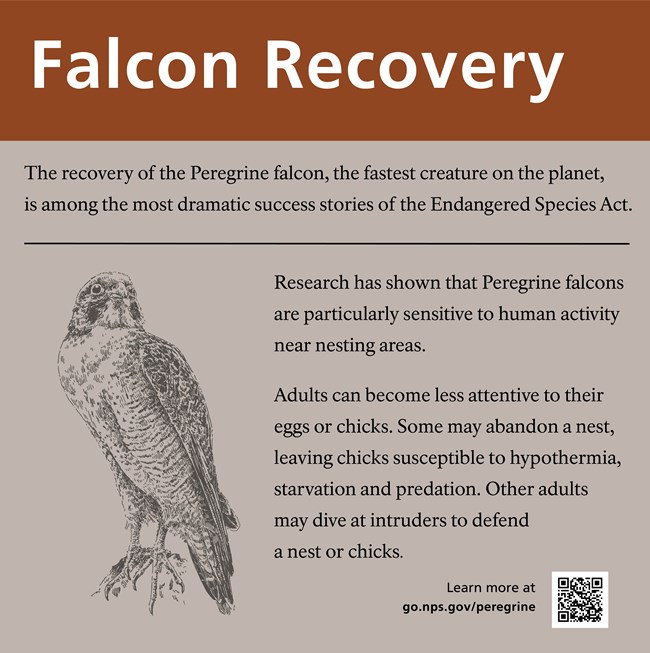Last updated: July 17, 2023
Article
View From the Aerie: Peregrine Falcon Watch in 2023
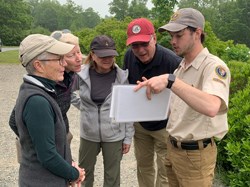
SCA Raptor Intern 2023
Acadia National Park
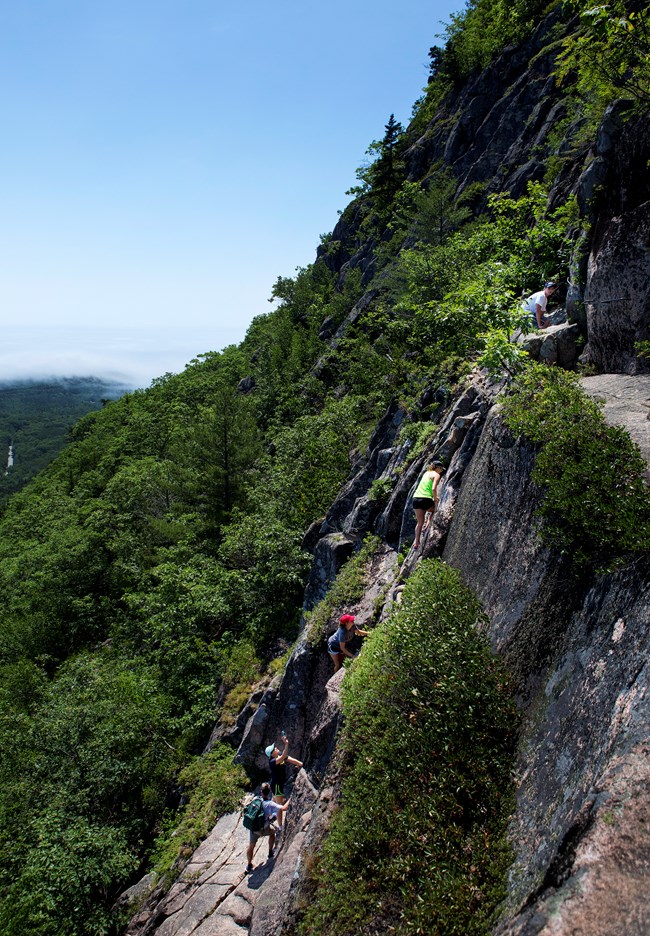
Ashley L. Conti, Friends of Acadia
June 5, 2023
You may wonder why the infamous Precipice Trail, along with Jordan Cliffs and Valley Cove trails, are closed during the most popular season at Acadia National Park. Conservation efforts are the culprit of these closings. The once endangered peregrine falcon has been protected since 1970 to save them from extinction. DDT pesticide overuse was the main reason for the decline of peregrine falcon populations. A Peregrine Falcon Watch program (PEFA) is offered at the Precipice Trail parking lot where scopes are set up to view the nesting area and falcons. The main goal of the program is to enhance visitor understanding and appreciation for reintroducing and protecting native species.
Acadia National Park typically hires a Raptor Intern through the Student Conservation Association to assist with the Peregrine Falcon Watch. My name is Logan Witt, and I am the Raptor Intern for the 2023 season. Birds are fascinating to me, and I am ecstatic to learn as much about them as possible and share my knowledge. I grew up in a small town in Iowa where I found my passion of protecting and conserving wildlife and the environment. I recently graduated with a Bachelor of Science in Environmental Science from Iowa State University. Through my education and experiences, I found my main interest in informing the public on the importance of conservation and sustainable practices.
The PEFA program is an amazing opportunity for people in the community to become more interested and knowledgeable about ways national parks conserve natural resources. I am honored to be a part of this amazing program and excited to invite all of you along on this journey of watching the chicks (eyases) grow up. Having the public be involved in this program is the perfect way for the community to create a pride and personal understanding of these amazing raptors, and more support for their overall protection. Using the falcons as an example is the perfect way for enhancing visitor appreciation for reintroducing and protecting other native species as well. My plan is to delve deeper into the history and fun facts about this program throughout the season.
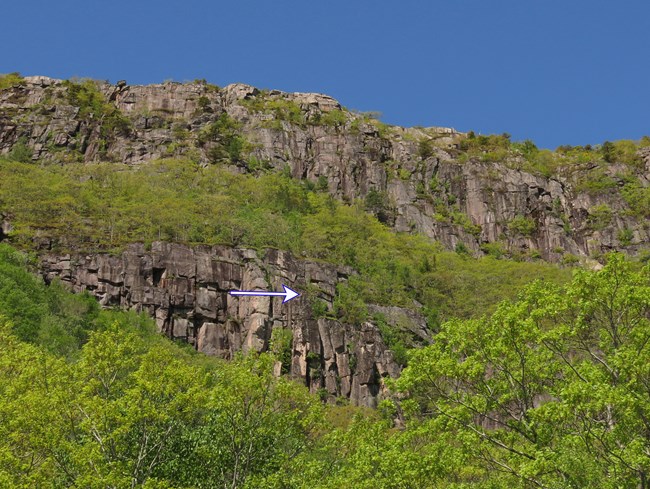
NPS Photo by Logan Witt
June 12, 2023
The chicks are at an age to where they will begin trying to fledge by the end of the month. While they are young, they can be compared to cotton or snowballs, you can sometimes spot them poking their heads out of the nest and enjoying the view from the cliff.
Parent falcons have been busy with catching and transferring food, chasing away everything in their territory, and saving some time to pose for those of us looking at them through scopes. They also have no trouble making sure they are being heard, screeching from the bottom of the cliffs.
In nice weather, peregrine falcons are most active during dawn and dusk, where they will spend most of their time hunting. Hot afternoons or rainy days seem to be a little less action packed, as the birds would prefer to stay out of harsh weather. Do not let the weather stop you from stopping at the program, a cloudy dreary day was a great day to see the falcons perched on the cliff and still chasing off other birds.
Banding is important to assist in the knowledge of where peregrine falcons and other birds travel throughout their lifetime. Some other information gained from banding includes life-span, travel distance, where they spend winter, and how young they are when they start to breed. Data can be combined to estimate survivorship of young chicks after independence, and overall help to demographically predict how many nests are required in an area to insure proper population in a region.
Recently, the chicks at the Precipice Trail site have been banded by Wildlife Management staff here at Acadia National Park. Thanks to this process, we were given the information of having two girls and one boy chick! We will have to brainstorm some names for them soon.
Banding can only happen in a short period of time when the chicks are the perfect size at 21-25 days old. Too small, and the band will slip right off, but too big and they are fearful of humans and difficult to band. Peregrine falcons are very territorial and aggressive birds; they can be seen chasing off eagles, vultures, and other birds away from the nest site. To no surprise, the falcons have no issue with trying to chase away humans, causing the banders to wear hard hats and other protective gear.
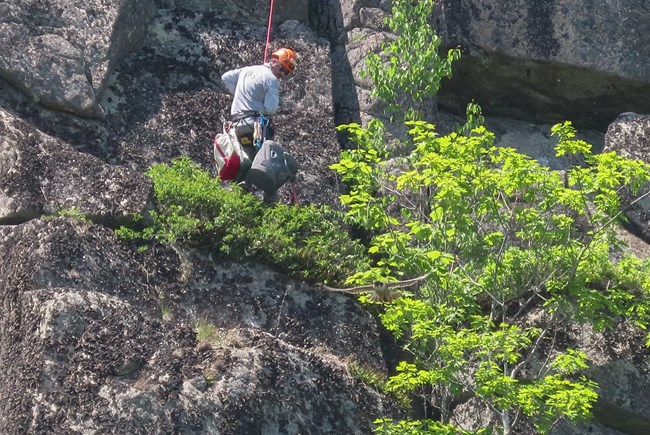
NPS Photo by Molly Mays
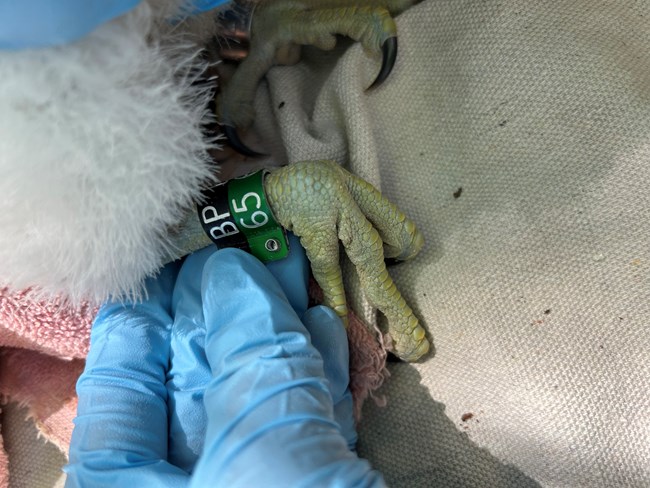
NPS Photo
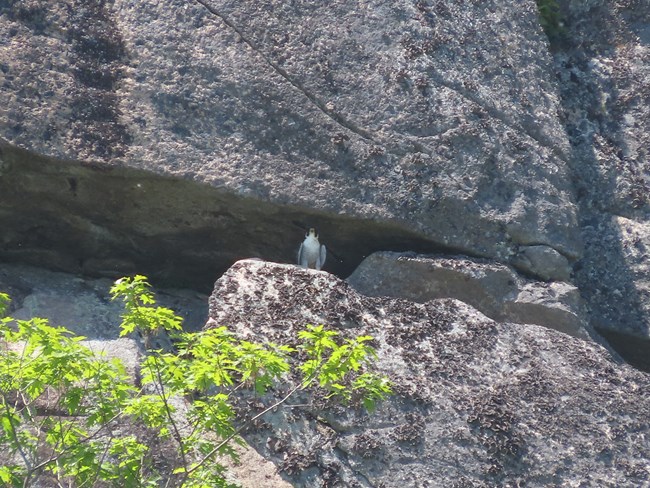
NPS Photo by Molly Mays
June 19, 2023
Somewhat like the weather here at Acadia National Park, the chicks are changing and fast! Last week they looked similar to white puffballs and this week there are little to no white downy feathers left. They are growing up too fast! With them getting closer and closer to fledgling age, the chicks can often be seen out on the edge of their nest or scrape.
Peregrine falcons do not make a traditional nest, but instead find a space on a cliff and ‘scrape’ away any rocks or gravel. This year the scrape can hardly be seen with the naked eye, but recently you can see the chicks moving and flapping their wings from the parking lot. You can tell they are wanting to take their first flight soon. Recently we have been getting some spectacular views of the chicks and adults through the scopes.
One difficult thing about the Peregrine falcon watch program is we cannot rely on always seeing the birds due to foggy conditions or times when they prefer to stay out of our view. During times of no visible falcons we have some interesting props and pictures for visitors to view instead. Pictures include the cliff face and scrape location, how the chicks change appearance transitioning from being born to fledgling age, adult versus juvenile falcons, and some examples of the reintroduction process here at Acadia National Park. For props we have replicas of peregrine falcon eggs, a claw, an example of their wingspan and a skull to examine. A ranger and myself will be available at the program to answer any questions you may have and inform you on the many interesting facts about peregrine falcons.
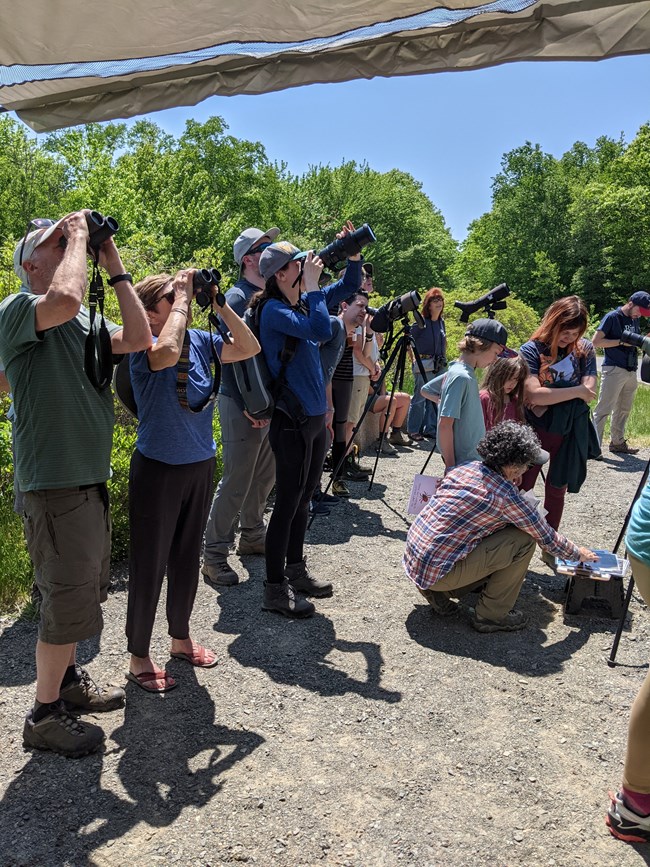
June 26, 2023
1…2…3… Liftoff!!! The chicks have taken to their instincts and flown away from the comfort of their nest! They can now be considered fledglings. Fog on and around Mount Champlain has made it difficult to even see the cliff face for multiple days. On our first day of good weather, we did not notice much activity in the scrape. There was an incredible amount of flight sightings from what we thought were the two adults. After further inspection, we noticed some of the flights we witnessed were actually the chicks! We got the chance to see a parent and a fledgling sharing a meal on a nearby cliff edge.
Unfortunately, only two of the three fledglings have been sighted in the past week or two. We are hopeful the third fledgling has just been out of sight, but it is difficult to tell for sure. There is about a 25 percent chance that a juvenile falcon will survive to the age of 2 years old. Once they reach the age of two they have a better chance of survival. The oldest peregrine falcon recorded in the wild was estimated to be about 19 years old!
One day we arrived at the parking lot and instantly saw four falcons flying together in the air, the parents seemed to be giving them some lessons. It is fascinating to me how quickly the fledglings learned to fly. Throughout the program we have seen the parents performing aerial food transfers to the fledglings, which is something they will do more with their future mates. We even witnessed the fledglings protecting their territory and chasing away a juvenile bald eagle!
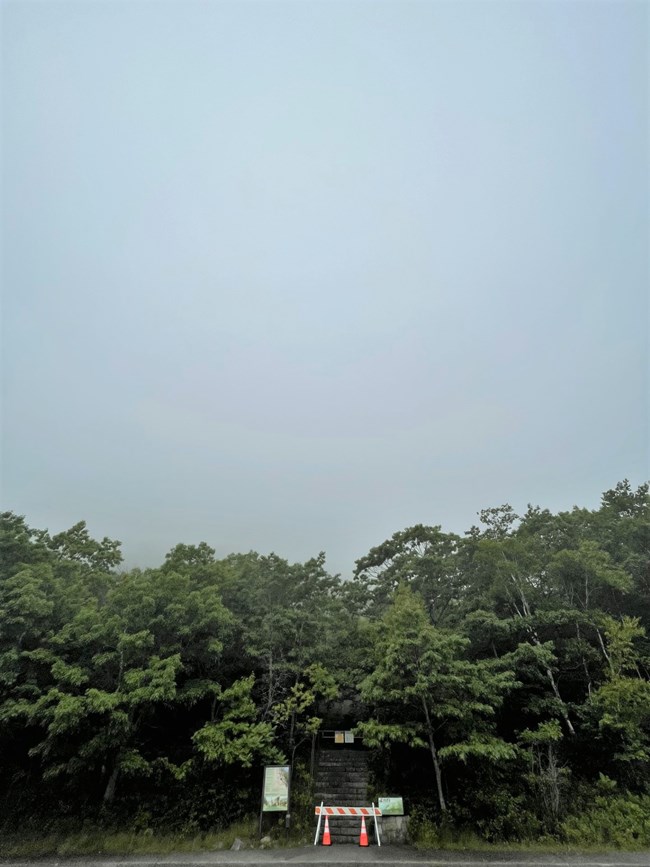
NPS Photo
July 3, 2023
Unfortunately, the weather has not been on our side recently. It is almost the third week in a row with a forecast of constant fog and rain. Fog makes it nearly impossible to see the falcons, and we cannot use our scopes in the rain. Since there is a lack of exhilarating updates for everyone, I thought now is a perfect time to talk more about the history of peregrine falcons here at Acadia National Park.In the 1950’s peregrine falcon numbers were becoming very low, especially in eastern North America. Dichlorodiphenyltrichloroethane (DDT) is an insecticide that was commonly used around the world in the mid 1900’s. Being such an effective insecticide, it saved an estimated 25 million people from malaria. In the late 1950’s it was first noted how DDT was affecting birds. The higher up in the food chain, the more DDT accumulated in their system. Since peregrine falcons are at the top of their food chain, they were highly affected. While the DDT did not directly kill the birds, it altered their calcium metabolism in a way that resulted in very thin eggshells causing egg breakages. In 1964 a survey of historic peregrine nest sites showed no successful nesting pairs in the Eastern US. DDT was banned in 1972 and some bird species recovered well on their own, while the peregrine falcon needed some assistance.
1956 was the last year we had a successful nest on Champlain Mountain. Cornell University, with the help of the Peregrine Fund, started captive breeding and reintroduction in 1972. Wild peregrine falcons were provided from around the world for captive breeding and hacking. Hacking is a process of hatching chicks in captivity and placing them into a “hack box” on a cliff for protection, and releasing them into the wild. During this process, the chicks were fed with a puppet or through tubes so they did not associate food with humans. The idea was for the falcons to return to historic nesting sites here in Acadia. Since the young birds imprint on the area where they are raised, it was likely that they would return to make nests of their own. It worked! 1991 was when the first successful nest was seen again on Champlain Mountain, and we have had a nest on the cliff since! Acadia National Park has produced more than 170 peregrine falcons since the reintroduction. Peregrine falcons were delisted from being endangered in 1999!
July 10, 2023
Nearing the end of the peregrine falcon nesting season, there is not as much to update you on about the falcons. The sun has been shining again, finally, giving us great views of the birds and the cliff. We have been seeing a lot more of the juveniles than the adults, who tend to be out hunting for the family. The juveniles are getting to the age where the parents are going to start easing them off their help. In a couple weeks, the juveniles will be fully independent and go their own way. When we no longer have any sights of the falcons for a couple days, the peregrine falcon watch program will end and the Precipice Trail will reopen, until next March.
A main part of this program is to answer any questions visitors have for us. With peregrine falcons being the fastest animal in the world, a common question is how fast can they really go? A trained peregrine was once dropped from an airplane at 12,000 feet and was recorded going as fast as 247 miles an hour! They get their incredibly fast speed from diving or stooping from high elevations. While naturally they would typically not dive at speeds that fast, they definitely have the ability to. Peregrines can fly an average of 65mph during level flight without diving.
Another common question is, what do they eat? Other raptors tend to have varied diets, depending on the species, including fish, small mammals, birds, et cetera. Peregrine falcons are adapted to be excellent bird hunters, which is mainly what their diet consists of. Their fast speed, smaller size, spectacular eyesight and preference of nesting on cliffs, aid them in their hunt for birds. Peregrine falcons are about the size of a crow, so they typically eat smaller birds like pigeons and songbirds but have been seen catching birds as large as a duck or gull. Female peregrines are noticeably larger than males, needing slightly more food. Size difference is the main way you can tell them apart as they look almost identical. When females in a species are larger than males, it is called reversed sexual dimorphism. The reasoning for the size difference is mostly unknown, with one theory being that that producing eggs requires more resources.
July 17, 2023
This week is sadly the last week of the Peregrine Falcon Watch Program for the 2023 season. These past few weeks, the parent falcons have been busy teaching their fledglings everything they know about flying, hunting, and overall survival. A fledgling's first successful hunt can be as early as two and a half weeks after leaving the nest for the first time. Even after a fledgling can fend for itself, they will still try to beg for food from their parents. The parents slowly wean the fledglings off their assistance. Within the next couple of weeks, we will see less and less of the falcons until they inevitably wander off.
What happens next? Peregrines tend to migrate with their food source. There have been cases in the past where the Precipice pair have been spotted here throughout the cold winter. Most peregrines would typically wander South until they find a reliable food source and spend their winter in that area. Most of the falcons in Eastern North America are a “created” population, through reintroduction, so there is no historic pattern of migration in their genes. One of our banded chicks, from Acadia National Park, was found as far South as Cuba!
This program is truly amazing, and I am so grateful to have been such a big part of it this season. It was a great experience watching the falcons grow up and teaching people more about them and the importance of their conservation. Nothing compares to witnessing the excitement from kids and adults seeing the peregrine falcons, and it feels amazing to share my love for them. I really appreciate everyone who has gone through this journey with me, especially those of you who have given me thanks in person. This may be the dreaded end of Peregrine Falcon Watch, but keep an eye out for my next blog focusing on the Hawk Watch Program, starting late August.

